模块1 Unit 2 Heroes一般现在时;过去时;将来时.以及进行时态 课件(共47张幻灯片)
文档属性
| 名称 | 模块1 Unit 2 Heroes一般现在时;过去时;将来时.以及进行时态 课件(共47张幻灯片) |  | |
| 格式 | zip | ||
| 文件大小 | 1.8MB | ||
| 资源类型 | 教案 | ||
| 版本资源 | 北师大版 | ||
| 科目 | 英语 | ||
| 更新时间 | 2019-07-05 22:19:55 | ||
图片预览

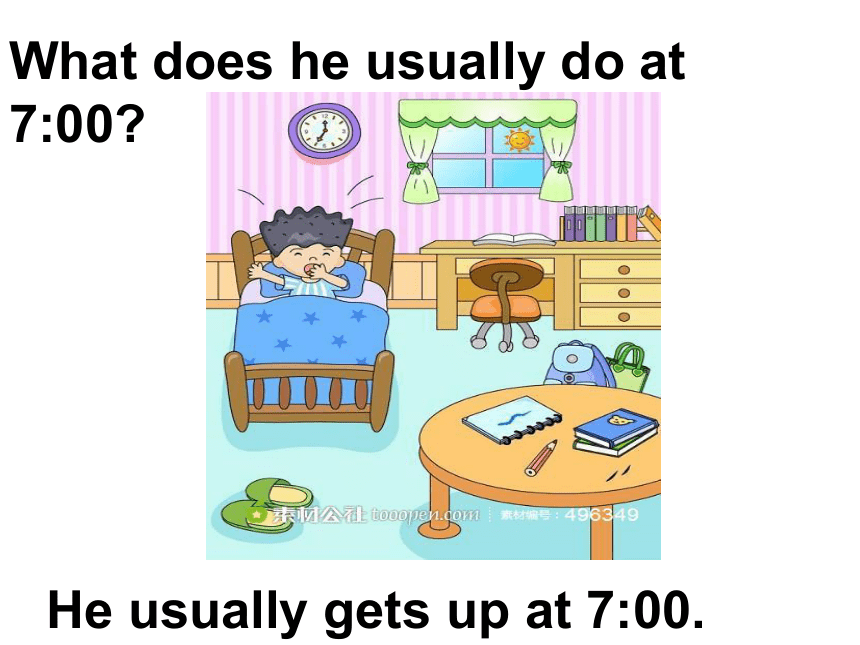
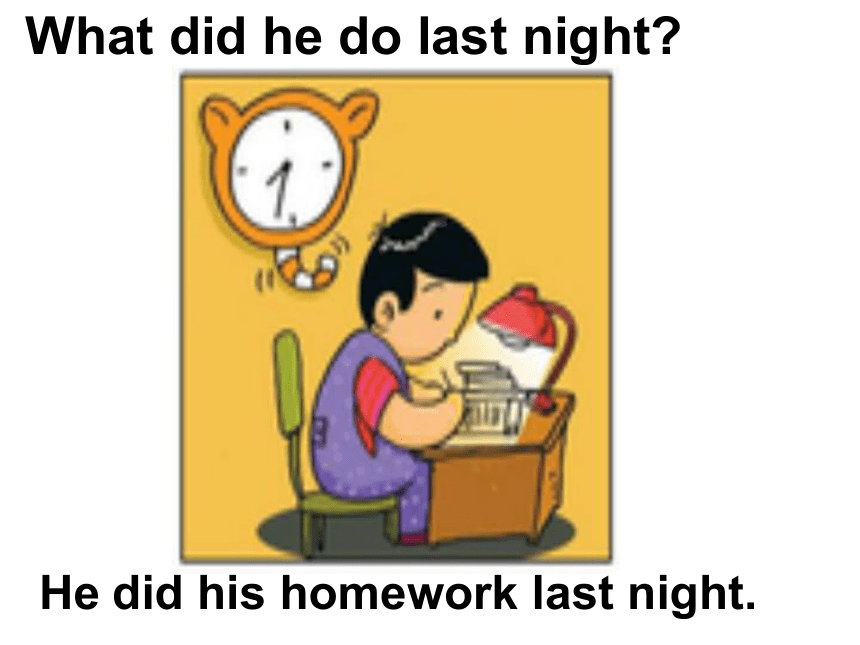


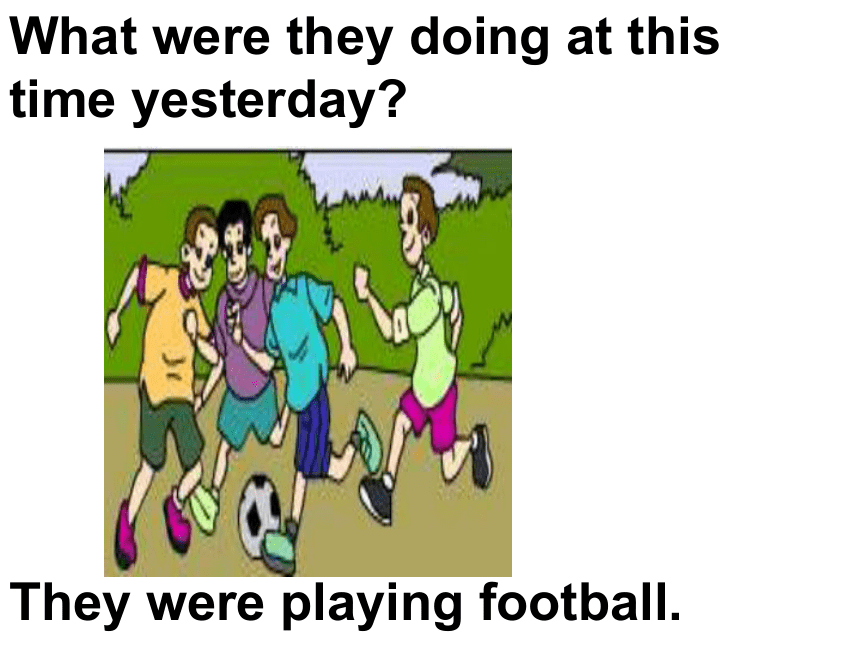
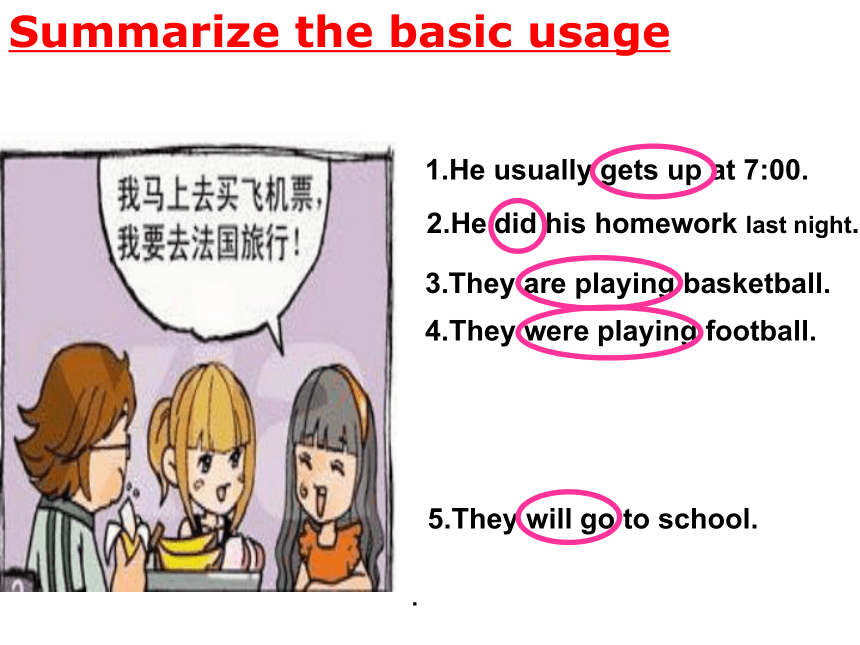
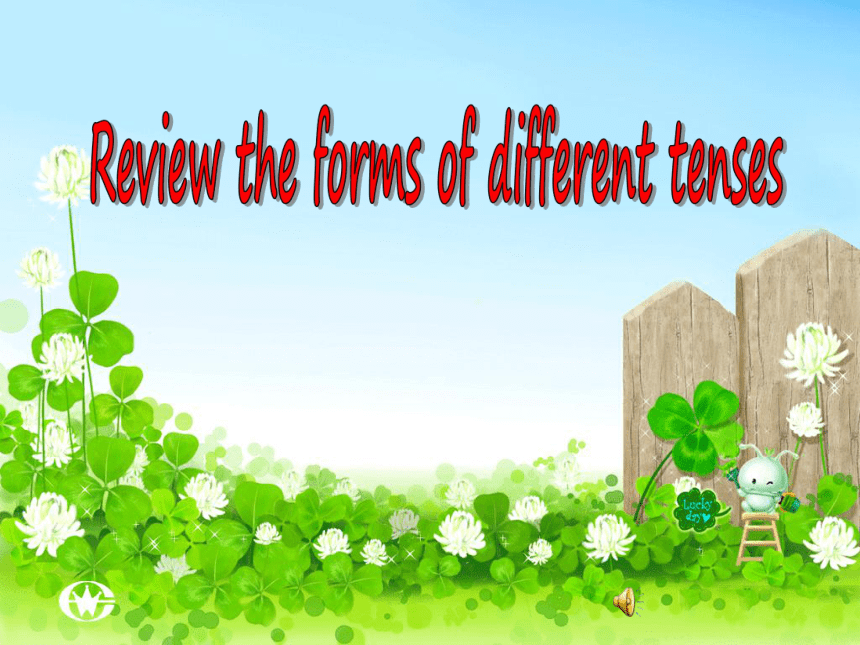
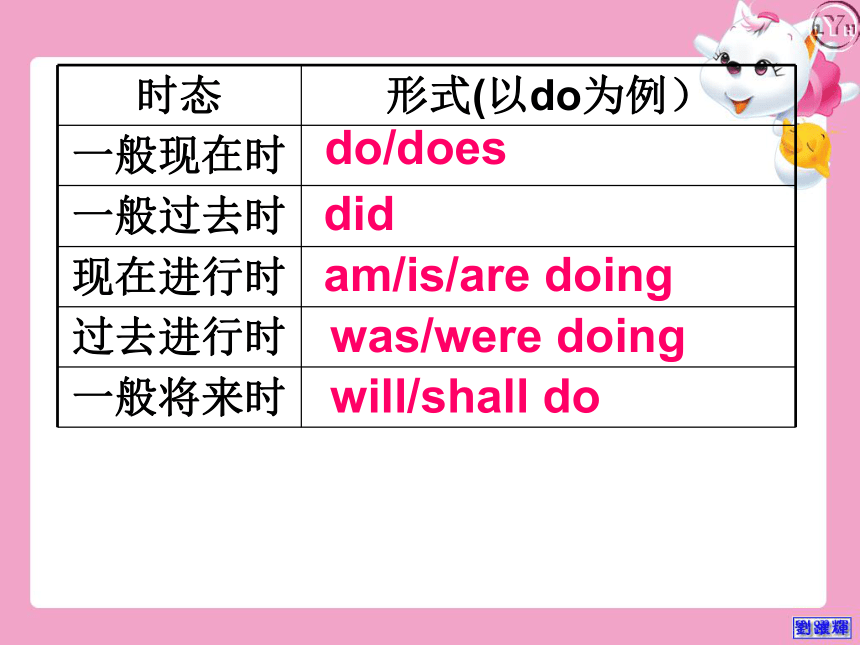

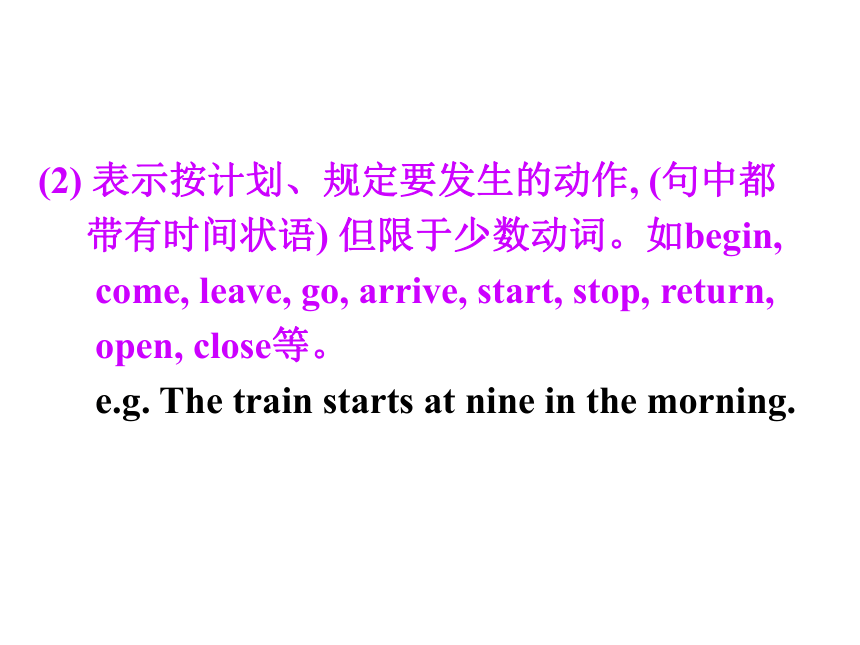

文档简介
课件47张PPT。英语的时态What does he usually do at 7:00?He usually gets up at 7:00.What did he do last night?He did his homework last night.What will they do after breakfast?They will go to school.What are they doing?They are playing basketball.What were they doing at this time yesterday?They were playing football. 1.He usually gets up at 7:00. 2.He did his homework last night. 3.They are playing basketball.4.They were playing football. 5.They will go to school.
.Summarize the basic usage Review the forms of different tensesdo/doesdidam/is/are doingwas/were doingwill/shall do1.一般现在时的用法
(1) 表示经常性、习惯性的动作和现在的状
态、特征, 句中常用often, usually, every
day等时间状语。
e.g. He goes to school every day.
(经常性动作)
He is very happy. (现在的状态)时态的基本用法(2) 表示按计划、规定要发生的动作, (句中都
带有时间状语) 但限于少数动词。如begin,
come, leave, go, arrive, start, stop, return,
open, close等。
e.g. The train starts at nine in the morning.(3) 书报的标题, 小说等情节介绍常用一般现
在时。
e.g. Xi meets journalists.
(4) 在时间状语从句和条件状语从句中, 用现
在时代替将来时。
e.g. If you come this afternoon, we’ll have a
meeting.2. 一般过去时的用法
(1) 表示过去某时间发生的事、存在的状
态或过去反复发生的动作。
e.g. He saw Mr. Wang yesterday.
He worked in a factory in 1986.(2) 表示过去经常发生的动作(也可用“used
to”或“would+动词原形”代替)。
e.g. During the vacation I often swam/would
swim in the sea.
I used to smoke.
注意: used to表示过去常发生而现在不再发生的动作或存在的状态。3. 一般将来时的用法
一般将来时表示将来的动作或状态, 其表达形式除了“will或shall+动词原形”外, 还有以下几种。
(1) “be going to+动词原形”, 表示即将发生的
或最近打算进行的事。
e.g. It is going to rain.
We are going to have a meeting today.(2) go, come, start, move, sail, leave等可用
进行时态表示按计划即将发生的动作。
e.g. I’m coming.
(3) “be to+动词原形”表示按计划要发生
的事或征求对方意见, 也可以表示命令、
禁止等。
e.g. Are we to go on with this work?(4) “be about to+动词原形”表示即将发生
的动作。
e.g. The plane is about to leave.
(5) 某些表示位移、停留等的动词其现在
进行时可表示按计划或不久之后肯定
发生的动作或将要做的事。这类动词
有go, come, stay, leave, start等。4. 现在进行时的用法
(1) 表示此时此刻正在进行的动作, 由“be+现在分词”构成。
e.g. What are you doing?
(2) 与always, constantly等连用, 表示感
彩。
e.g. He is always helping others. 另外“系动词+介词或副词”也表示进行时的意义。
e.g. The bridge is under construction. 注意:下列动词不宜用进行时
① 感觉类:look, smell, feel, sound, taste, see,
hear等;
② 感情类:like, love, prefer, admire, hate,
fear等;
③ 所有类:have, contain, own, hold, belong
to等。5. 过去进行时的用法
(1) 表示过去某一时刻、某一阶段正进行的动
作, 由“was (were)+现在分词”构成。
e.g. He was reading a novel when I came in.
(2) 与always, forever, constantly连用, 表示赞
成或厌恶的感彩。
e.g. He was always thinking of others, never
thinking of himself. Summarize the basic usage 现在的状态,经常性动作,客观真理过去的状态或过去的动作说话时或现阶段正在进行的动作过去某一时刻或某段时间正在发生的动作将要发生的动作或存在的状态 Summarize the adverbialsalways, often, usually, sometimes, every day/week/year…,
on Sundays, once a week…
Yesterday (morning, …), two years ago, last night/year, in 1990, in the past, the day before yesterday, the other day…
now, at present…
at this time yesterday,
at eight yesterday evening,
all day yesterday…
tomorrow, soon, next year, the day after tomorrow, in the future…
homework
1. My mother _________(play) the piano every Sunday.
2. Our math teacher _______ (grade) our schoolwork now.
3. By the end of last year, we ________(produce)20,000 cars.
4. My brother __________(go) to London last summer.
5. We were all surprised when he made it clear that he _____________(leave) office soon.
6.In the past ten years, China ____(witness) great changes.
7. A new teacher _____________ (come) tomorrow.
8. We _________(have) a math class at this time yesterday. 谢谢指导!
.Summarize the basic usage Review the forms of different tensesdo/doesdidam/is/are doingwas/were doingwill/shall do1.一般现在时的用法
(1) 表示经常性、习惯性的动作和现在的状
态、特征, 句中常用often, usually, every
day等时间状语。
e.g. He goes to school every day.
(经常性动作)
He is very happy. (现在的状态)时态的基本用法(2) 表示按计划、规定要发生的动作, (句中都
带有时间状语) 但限于少数动词。如begin,
come, leave, go, arrive, start, stop, return,
open, close等。
e.g. The train starts at nine in the morning.(3) 书报的标题, 小说等情节介绍常用一般现
在时。
e.g. Xi meets journalists.
(4) 在时间状语从句和条件状语从句中, 用现
在时代替将来时。
e.g. If you come this afternoon, we’ll have a
meeting.2. 一般过去时的用法
(1) 表示过去某时间发生的事、存在的状
态或过去反复发生的动作。
e.g. He saw Mr. Wang yesterday.
He worked in a factory in 1986.(2) 表示过去经常发生的动作(也可用“used
to”或“would+动词原形”代替)。
e.g. During the vacation I often swam/would
swim in the sea.
I used to smoke.
注意: used to表示过去常发生而现在不再发生的动作或存在的状态。3. 一般将来时的用法
一般将来时表示将来的动作或状态, 其表达形式除了“will或shall+动词原形”外, 还有以下几种。
(1) “be going to+动词原形”, 表示即将发生的
或最近打算进行的事。
e.g. It is going to rain.
We are going to have a meeting today.(2) go, come, start, move, sail, leave等可用
进行时态表示按计划即将发生的动作。
e.g. I’m coming.
(3) “be to+动词原形”表示按计划要发生
的事或征求对方意见, 也可以表示命令、
禁止等。
e.g. Are we to go on with this work?(4) “be about to+动词原形”表示即将发生
的动作。
e.g. The plane is about to leave.
(5) 某些表示位移、停留等的动词其现在
进行时可表示按计划或不久之后肯定
发生的动作或将要做的事。这类动词
有go, come, stay, leave, start等。4. 现在进行时的用法
(1) 表示此时此刻正在进行的动作, 由“be+现在分词”构成。
e.g. What are you doing?
(2) 与always, constantly等连用, 表示感
彩。
e.g. He is always helping others. 另外“系动词+介词或副词”也表示进行时的意义。
e.g. The bridge is under construction. 注意:下列动词不宜用进行时
① 感觉类:look, smell, feel, sound, taste, see,
hear等;
② 感情类:like, love, prefer, admire, hate,
fear等;
③ 所有类:have, contain, own, hold, belong
to等。5. 过去进行时的用法
(1) 表示过去某一时刻、某一阶段正进行的动
作, 由“was (were)+现在分词”构成。
e.g. He was reading a novel when I came in.
(2) 与always, forever, constantly连用, 表示赞
成或厌恶的感彩。
e.g. He was always thinking of others, never
thinking of himself. Summarize the basic usage 现在的状态,经常性动作,客观真理过去的状态或过去的动作说话时或现阶段正在进行的动作过去某一时刻或某段时间正在发生的动作将要发生的动作或存在的状态 Summarize the adverbialsalways, often, usually, sometimes, every day/week/year…,
on Sundays, once a week…
Yesterday (morning, …), two years ago, last night/year, in 1990, in the past, the day before yesterday, the other day…
now, at present…
at this time yesterday,
at eight yesterday evening,
all day yesterday…
tomorrow, soon, next year, the day after tomorrow, in the future…
homework
1. My mother _________(play) the piano every Sunday.
2. Our math teacher _______ (grade) our schoolwork now.
3. By the end of last year, we ________(produce)20,000 cars.
4. My brother __________(go) to London last summer.
5. We were all surprised when he made it clear that he _____________(leave) office soon.
6.In the past ten years, China ____(witness) great changes.
7. A new teacher _____________ (come) tomorrow.
8. We _________(have) a math class at this time yesterday. 谢谢指导!
